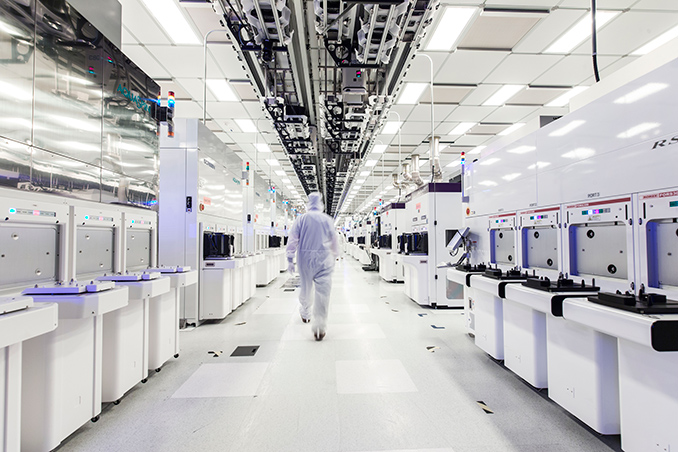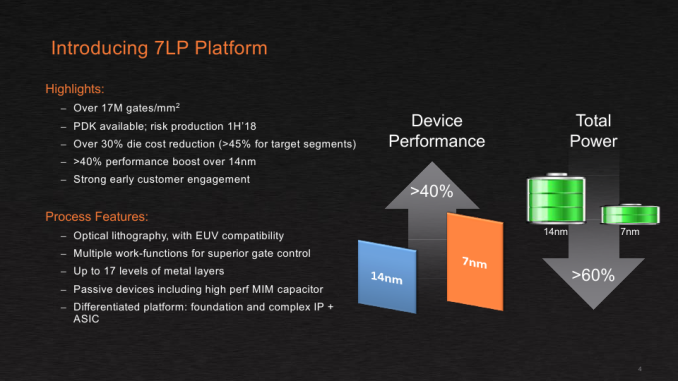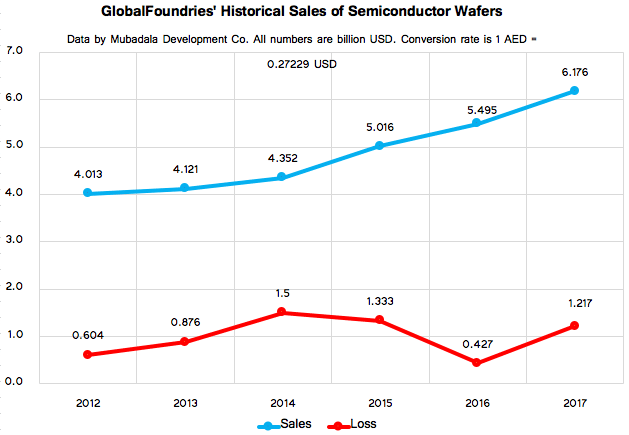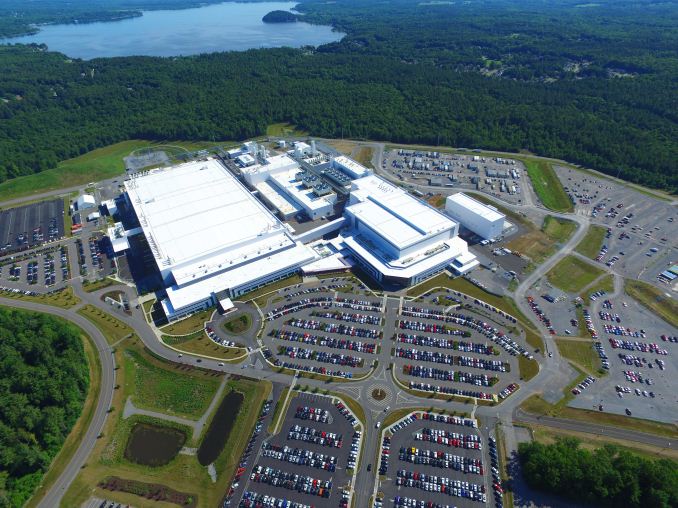GlobalFoundries Stops All 7nm Development: Opts To Focus on Specialized Processes
by Anton Shilov & Ian Cutress on August 27, 2018 4:01 PM EST- Posted in
- Semiconductors
- CPUs
- AMD
- GlobalFoundries
- 7nm
- 7LP

GlobalFoundries on Monday announced an important strategy shift. The contract maker of semiconductors decided to cease development of bleeding edge manufacturing technologies and stop all work on its 7LP (7 nm) fabrication processes, which will not be used for any client. Instead, the company will focus on specialized process technologies for clients in emerging high-growth markets. These technologies will initially be based on the company’s 14LPP/12LP platform and will include RF, embedded memory, and low power features. Because of the strategy shift, GF will cut 5% of its staff as well as renegotiate its WSA and IP-related deals with AMD and IBM. In a bid to understand more what is going on, we sat down with Gary Patton, CTO of GlobalFoundries.
7LP Canned Due to Strategy Shift
GlobalFoundries was on track to tape out its clients’ first chips made using its 7 nm process technology in the fourth quarter of this year, but “a few weeks ago” the company decided to take a drastic, strategic turn, says Gary Patton. The CTO stressed that the decision was made not based on technical issues that the company faced, but on a careful consideration of business opportunities the company had with its 7LP platform as well as financial concerns.
It is noteworthy that when GlobalFoundries first announced its 7LP platform in September 2016, it said that it would start risk production of processors using this technology in early 2018 (PR), which means that the first chips should have been taped out before that. When the company detailed the process in June 2018, it said that it expected to start “volume production ramping in the second half of 2018” (PR), which would be close to impossible if customers taped out their first chips only in Q4.
Generally, it looks like the company had to adjust its roadmap somewhere along the way, moving the start of high-volume manufacturing (HVM) further into 2019. Whether or not these adjustments had any implications on GlobalFoundries is up to debate. Keep in mind that AMD’s first 7 nm product was designed for TSMC’s CLN7FF from the beginning, so the company did not bet on GF’s 7LP in late 2018 anyway, and no rush with the manufacturing technology was needed for GF’s key customer.
Along with the cancellation of the 7LP, GlobalFoundries essentially canned all pathfinding and research operations for 5 nm and 3 nm nodes. The company will continue to work with the IBM Research Alliance (in Albany, NY) until the end of this year, but GlobalFoundries is not sure it makes sense to invest in R&D for ‘bleeding edge’ nodes given that it does not plan to use them any time soon. The manufacturer will continue to cooperate with IMEC, which works on a broader set of technologies that will be useful for GF’s upcoming specialized fabrication processes, but obviously it will refocus its priorities there as well (more on GF’s future process technologies later in this article).
So, the key takeaway here is that while the 7LP platform was a bit behind TSMC’s CLN7FF when it comes to HVM – and GlobalFoundries has never been first to market with leading edge bulk manufacturing technologies anyway – there were no issues with the fabrication process itself. Rather there were deeper economic reasons behind the decision.
Economic Reasons Behind the Move
As we noted in our article covering GlobalFoundries's new CEO hire earlier this year, former CEO Sanjay Jha was never able to make the company profitable. His key tasks were to increase GlobalFoundries’s sales, streamline the company in general, and ensure that it executes its roadmap.
To address the needs of the manufacturer’s traditional key client (AMD) and ensure that his company was competitive against other contract makers of semiconductors, he licensed Samsung Foundry's 14LPP fabrication technology. That strategy worked well. With Sunjay Jha at the helm, GlobalFoundries has managed to land a variety of new customers and increase its sales of semiconductor wafers from approximately $4.121 billion in 2013 to $6.176 billion in 2017. Besides, the foundry’s leading-edge Fab 8, which has been processing wafers using exclusively 14LPP process technology for well over 1.5 years now, is running at full capacity.
To ensure that GlobalFoundries remains competitive against Samsung Foundry and TSMC in the long run, Sunjay Jha obtained IP and development teams from IBM (along with two fabs and a lot of obligations), and poured in billions of dollars in development of the 7LP fabrication technology platform. The latter would include three generations of manufacturing processes and, possibly, a custom high-performance technology available exclusively to IBM. While everything appeared to proceed smoothly with the 1st Gen 7 nm process (DUV only), the 2nd Gen 7 nm process (with EUV used for non-critical layers, such as padding) still needed some additional development investments, and the 3rd Gen 7 nm (with intensive usage of EUV) required even more money for development and further could require installation of additional EUV equipment. Meanwhile, there were two things to consider.
First. If GlobalFoundries kicks off production using the 1st Gen 7 nm fabrication process, it would have needed to cure all of its teething troubles and offer its clients a roadmap forward. The latter would have included 2nd Gen and 3rd Gen 7 nm, but nothing stops there. Customers would have asked for 5 nm and then for 3 nm nodes. Meanwhile, you cannot tell your clients that you are packing up after a certain node and then hope that this node will be a success (the same is true for DUV-only 1st Gen 7 nm).
Second. Development of leading-edge process technologies is extremely expensive. Every new node requires billions of dollars in investments. Those costs are eventually amortized over each chip the company makes, so to keep increasing R&D costs from driving up chip prices, foundries need to produce more chips. To make more chips, they need to either run multiple fabs that use the same process technology (these are going to cost $10+ billion in the EUV era), or build giant fabs that process a gargantuan number of wafers (these are going to cost $20+ billion in the EUV era). Meanwhile, GlobalFoundries has only one leading-edge fab featuring capacity of 60,000 wafer starts per month. As a result, either GlobalFoundries has to pass these R&D costs on to the finite number of wafers it processes – and become uncompetitive against rivals in the process – or eat the costs with reduced profitability.
Meanwhile, having spent well over $20 billion on GlobalFoundries over the last 10 years, Mubadala, the owner of the company, is not inclined to lose more money or invest tens of billions in the hopes of becoming profitable one day. The investor wants GlobalFoundries to stop bleeding and start generating profits.
“The culture of [our investments], the ones I’ve been involved with, was about accumulating assets and then just maintaining it,” said Mubadala CEO Khaldoon Al Mubarak in an interview with Bloomberg earlier this year. “The shift that has happened over the last couple of years, that I’ve tried to push at Mubadala today, is a monetization strategy that makes sense, not with a view to cash out but with a view to reinvest.”
Gary Patton admits that GlobalFoundries never planned to be a leading producer of 7-nm chips in terms of volume. Furthermore, the company has been seeing increasing adoption of its 14LPP/12LP technologies by designers of various emerging devices, keeping Fab 8 busy and leaving fewer step-and-scan systems for 7LP products.
Without another big fab, it would be impossible to make any new leading-edge process technology competitive against Samsung and TSMC due to aforementioned scale reasons. Meanwhile, building a new fab (or even expanding the Fab 8 with another clean room module, which is something that GF considered several years ago) and creating another node or two would require another $10 – $15 billion from Mubadala, which is not inclined to invest just now. As a result, the GlobalFoundries has decided to switch entirely to specialized process technologies for emerging high-growth markets. This strategic shift enables it to reduce spending on R&D, slowdown procurement of new equipment, reduce its workforce by 5% (most of which will be in Malta), and potentially avoid direct competition against the aforementioned contract makers of semiconductors.













127 Comments
View All Comments
RSAUser - Tuesday, August 28, 2018 - link
Their 7nm is probably slightly better than Intel 10nm.Think someone linked some papers a while back stating that TSMC and Samsung have likely already overtaken or are soon to overtake Intel.
eastcoast_pete - Tuesday, August 28, 2018 - link
I actually agree with the notion that x nm doesn't equal x nm when comparing different processes. However, Intel's 10 nm process has (continues to have?) had many teething problems, and scale-up has been delayed and apparently almost painful. My thought was that this is a potential chance for Intel to buy valuable IP, expertise and basically new state-of-the-art equipment at bargain basement prices. I know that they like to do everything as much in-house as possible, but Intel has made large acquisitions in recent years if they thought they would add to their bottom line.Kevin G - Monday, August 27, 2018 - link
1) Is the most likely scenario. Everyone is having problems as EUV is late for everyone and the alternatives are quad patterning which adds costs and slows production. It is a bag of hurt. 5 nm was looking like it could only be developed by masochists.2) Not improbable was GF was never that aggressive with their roadmap. The problem is that the other players hit delays so the reality likely was that GF was never going to be that far behind. Perception is everything. Spinning off 7 nm production would still require customers to come forward. This is a clear chicken and the egg scenario where the customers decided to roost else where.
As for other players purchasing GF, it is unlikely as companies like Intel actually have an excess of capacity for logic right now (DRAM and flash are slightly different which are higher utilized). The exception as noted would be keeping the US fabs in the Trusted Foundry Program. Certain stipulations had to be adhered to for GF to inherent those as part of the purchase of IBM's fabs. As such, there are likely conditions that still exist for the sale of those fabs. If another member of the Trusted Foundry Program just wanted those fabs, it would be far easier to change ownership.
bourbon_high - Monday, August 27, 2018 - link
Rumours last year said that the previous CEO Mr. Sanjay Jha and his team wanted to stop investing in 7 because the IBM led management team in Malta was behind and struggling. the current management team it seems was against 22fdx but pushed for 7nm. now after failing to deliver, the same management team under pressure from their investors and AMD have given up and seems to be calling it a strategy shift. Billions more wasted is what is said. GF needs new management, not dead weight IBM'ers that are slow to move if at all.rahvin - Monday, August 27, 2018 - link
The article clearly paints it as your number 2 scenario. When they did the math on buildout and customers they realized they'd loose money so they bagged the whole thing and decided to focus on their current process.Keep in mind there is still a ton of stuff fabbed on older process nodes, it can in fact by quite lucrative. With AMD unbound on manufacturing it also free's GloFo from having to spend billions building and upgrading Fabs. Given the rising costs in fabrication as they move up each node the market is likely to consolidate further and we could even see TSMC or Samsung drop out of the race due to the costs. Fab prices have gotten to the point of breaking budgets for even huge companies, there are very few companies that can afford to build a $20 billion EUV fab.
levizx - Tuesday, August 28, 2018 - link
You can't "spin-off" a process with NO FAB to produce it.eastcoast_pete - Tuesday, August 28, 2018 - link
Actually, you can, if you have a fab or two that can house the equipment and the people (the expertise) who are now being "made redundant" as the the British say. Processes have been moved ("migrated") from one fab to another in the past, although it can be a major pain in the derriere to do so.FullmetalTitan - Thursday, August 30, 2018 - link
Bigger issue then would be cost. Fab tool-in is expensive, even with retrofit work.Kevin G - Monday, August 27, 2018 - link
I wonder how this plays out for the Trusted Foundry programs that GF inherited from IBM. They allegedly had several contracts open with three letter agencies for specialized parts. Outside of that, they still provide some radiation hardened nodes as well (though far from state of the art). I'm not sure how profitable, if at all, things would be catering to those types of customers. While not high in volume, those due produce a nice margin. While the number bleeding edge nodes within the Trusted Foundry program is slim, there are plenty of players able to fab using older nodes. As the rest of the industry marches toward 7 nm and beyond, those other small time fabs will catch up.While IBM's contract with GF runs out at the end of this year, GF did develop a 12 nm FD-SOI process that looked like it was being used for a POWER9+ revision. Still those products would have been initially planned for a late 2019 release date.
btmedic04 - Monday, August 27, 2018 - link
My question in all of this is how will the fallout of Glofo abandoning 7nm affect AMD's 2nd gen Ryzen/Epyc processors